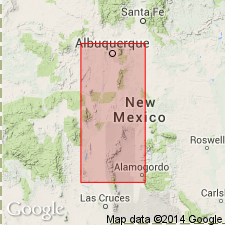
- Usage in publication:
-
- Whiskey Canyon limestone
- Modifications:
-
- Named
- Dominant lithology:
-
- Limestone
- Chert
- AAPG geologic province:
-
- San Juan basin
- Orogrande basin
Summary:
Named as middle member of Armendaris group (new) of Des Moines series for Whiskey Canyon, in north end of Mud Springs Mountains, where typically exposed. Type locality is section measured in west end of Whiskey Canyon in north portion of Mud Springs Mountains, just west of westernmost box canyon, in southwest part of sec 1, T13S, R5W, Sierra Co, NM in Orogrande basin. Composed of massive, bluish-gray to gray, cherty limestones 163 ft thick at type. This limestone is the most prominent of the lithologic units near base of the Pennsylvanian in central NM. Forms many of the prominent limestone cliffs of the mountain ranges of this region. Limestone is massive and resistant throughout, and contains several thick zones of light-gray chert near its base, and scattered masses and lenses of chert in its lower and upper portions. Is widespread in central and southern NM and is well developed from Nacimiento Mountains in the north (in San Juan basin) to the Franklin Mountains in the south. Fossiliferous; fauna is large and varied. However, because of resistant nature of unit, few mega-fossils collected. Abundant fusulinid foraminifers. Overlies Elephant Butte formation (new); underlies Garcia formation (new), both of Armendaris. Is of Pennsylvanian (Des Moines) age.
Source: GNU records (USGS DDS-6; Denver GNULEX).
For more information, please contact Nancy Stamm, Geologic Names Committee Secretary.
Asterisk (*) indicates published by U.S. Geological Survey authors.
"No current usage" (†) implies that a name has been abandoned or has fallen into disuse. Former usage and, if known, replacement name given in parentheses ( ).
Slash (/) indicates name conflicts with nomenclatural guidelines (CSN, 1933; ACSN, 1961, 1970; NACSN, 1983, 2005, 2021). May be explained within brackets ([ ]).

